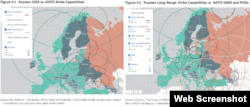In a piece about the U.S. Army’s modernization efforts published on July 20, the website of RT, Russia’s government-funded international broadcaster, claimed that a study by the Washington-based Center for Strategic and International Studies (CSIS) said the U.S. Army has fallen behind other technologically superior counterparts, especially Russia.
“In an effort to compete with more technologically advanced forces, the U.S. Army is investing in new programs to develop autonomous drones and create a network of battlefield devices that communicate with each other,” RT wrote. “…The Center for Strategic and International Studies (CSIS) released a report that found the US Army has fallen behind other technologically advanced states after spending nearly two decades fighting technologically inferior adversaries in the Middle East.”
Citing the CSIS report, RT suggested that Russia has a more technologically advanced military, which uses high-end anti-access/area denial (A2/AD) capabilities, presumably in Ukraine and Syria.
In fact, the CSIS report, published in May, stated: “Russia has either equaled or surpassed certain U.S. capabilities in A2/A2, ground combat, and non-kinetic operations.”
Russia’s A2/A2 capabilities, it said, present “a challenging, but not impossible, obstacle for defense planners,” in part due to Russia’s proximity to conflict theaters in Europe.
As for ground combat capabilities, CSIS said the rocket artillery systems of the two sides are “roughly technologically equivalent,” while U.S. capabilities in terms of situational awareness and soldiers have “considerable asymmetric advantages” over those of the Russian army.
In terms of non-kinetic capabilities (electronic warfare, offensive cyber, and information operations), the U.S. Army indeed lags behind its Russian counterpart, giving that it has focused on counterinsurgency rather than peer-to-peer or near-peer conflict operations and is facing budget declines.
But the CSIS report concludes that the U.S. Army still enjoys “an overall qualitative advantage over Russian and similar near-peer forces,” despite the narrowing gap in capabilities.
A 2015 RAND report comparing U.S. Army systems with foreign counterparts acknowledged that some militaries had “select advantages” over other militaries due to their modernization efforts. Nonetheless, it concluded: “In terms of overall capability, the U.S. Army remains in a league of its own—no other army in the world has the same depth and breadth of capabilities.”
Earlier this year, the Global Firepower Index, which focuses on quantitative and ignores qualitative differences, also put the U.S. military at the top.
The CSIS report, it should also be noted, looked at the A2/A2, ground combat, and non-kinetic operations capabilities of the U.S. Army, not the entire U.S. military. RT, for its part, failed to take into consideration the U.S. military’s overall capabilities, or the offensive and defensive operational advantages enjoyed by separate U.S. military branches or by joint U.S. fighting forces.
Still, the CSIS report conceded that the U.S. Army is currently at a disadvantage because it must rely on joint fighting forces (i.e., the air force and navy) for A2/A2 and non-kinetic capabilities.
RT also disregarded the impact of U.S. and Russian military budgets on the development and modernization of -- and investment in -- technologically advanced weapon platforms.
As Polygraph.info noted recently, a 2017 U.S. Defense Intelligence Agency (DIA) assessment of Russian military capabilities found that Russia faces “a critical gap” in the inventory of conventional precision-strike weapons relying on high-end technology.
Unlike the U.S., which has been using precision-guided munitions since at least the 1970s, Russia has used them in combat only minimally and, for the most part, only recently. As the DIA pointed out: “Russia was unable to achieve real progress in the development of precision strike until the first decade of the 21st century, when it was able to create a viable state armaments program that allowed prioritization of certain key components of 21st-century warfare.”
Russia has indeed been modernizing and developing its military, presenting the U.S. military with challenges that are real but not yet fully tested. It has also taken asymmetric approaches to coping with the U.S. military’s qualitative advantages, which explains why Russia’s military today enjoys a degree of technological advantage in some areas.
Still, there is no denying that Russia’s asymmetric approach stems from the country’s weaker military and economic potential – an approach aimed at ensuring military preparedness in the face of a technologically and qualitatively superior U.S. military force.






